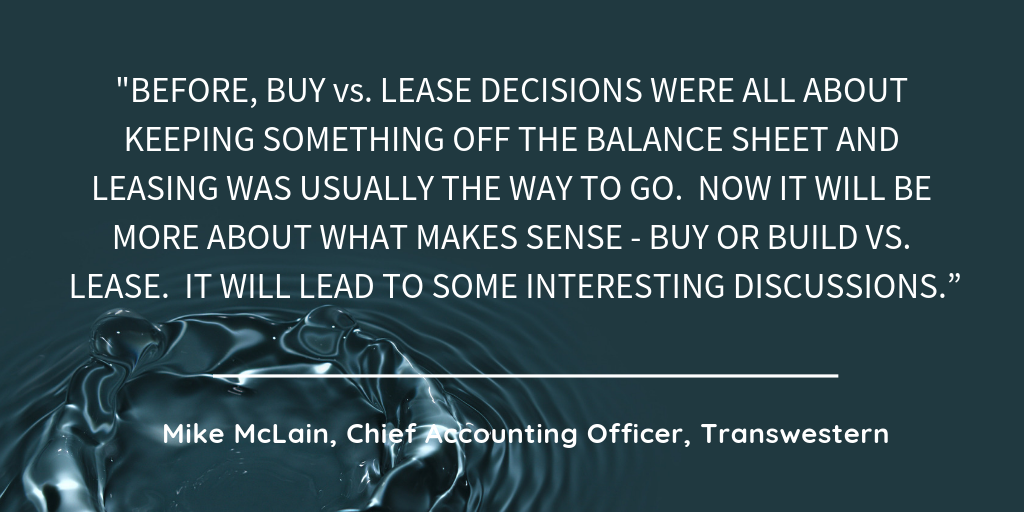In early 2016 when the FASB and IASB issued the new lease accounting standards, ASC 842 and IFRS 16, the effective date of December 15, 2019 for private companies likely felt very far away.
Now that date is less than a year away and many private companies are finally turning their attention from revenue recognition compliance projects to leasing. In a Q4 survey of over 450 finance professionals, PWC found that only 35% of private companies had leasing implementations in process and only 2% had completed projects.
ASC 842 and IFRS 16 have dramatically changed the way that leases are recorded on a company’s balance sheet. The new standard also modifies the definition of a lease and stipulates that individual contract parts can meet that definition. The criteria used to classify leases by lessees and lessors have been changed to be more principles based, and a new lease classification criterion has been added for specialized assets.
That’s a lot of change to account for. So, what should private companies be thinking about as they enter the final push to December 2019?
Don’t underestimate the time required to achieve compliance.
Between data identification and standardization, time to assess and decide on the required accounting judgments, and the implementation of a solution, there isn’t time to waste. Many public companies are learning this the hard way. The previously cited survey found that nearly 25% of organizations implementing systems changes stated that they were not expecting to be live before the impending date. Think about running lease data collection and software selection efforts in parallel to save time.
Be prepared for leasing compliance to drive changes in business behavior.
Six months ago, we wrote about some potential unintended consequences of the new lease accounting standards and they are just as relevant for private companies as pubic.
Recently, we spoke with Mike McLain, Chief Accounting Officer at Transwestern, a privately held real estate firm, about business changes stemming from ASC 842: “When companies start generating their calculations, they will likely see a significant increase in liabilities. If an organization has an option to renew and based on the way it’s written it’s highly likely they will exercise the option, well that number must go on the balance sheet. All of a sudden, 10 years of rent liability is on the balance sheet versus just the initial 5-year lease term. So how does the organization respond to that? Is it going to impact bank loan calculations? Before, buy vs. lease decisions were all about keeping something off the balance sheet and leasing was usually the way to go. Now it will be more about what makes sense – buy or build vs. lease. It will lead to some interesting discussions.”
Be wary of spreadsheet solutions.
54% of private companies reported the intention to use spreadsheets to achieve leasing compliance. While organizations with simple lease structures or a low lease volume will be able to manage with Excel, using spreadsheets may result in longer-term issues and hidden costs. Since the implementation of the standard will have a significant impact on the balance sheet, income statement and other key finance KPIs, the ability for finance teams to be able to explain and model scenarios is critical. This requirement will be difficult to satisfy using spreadsheets.
Complex lease structures will require extra attention.
One of the most difficult aspects of the new lease accounting standards is identifying and understanding the lease types in your portfolio. From subleases which trigger a lessor accounting requirement to variable payment leases which utilize a changing benchmark interest rate, it’s essential to understand what the accounting for each individual lease type entails.
Address compliance needs with an eye toward the future can pay dividends.
As McLain observes, “now that organizations have a big number that’s out there for everyone to see, it will force them to look at their lease portfolio more holistically.” We absolutely agree. While many companies are viewing compliance as the ultimate end goal, a forward-looking approach to thinking about the post-compliance lease accounting environment can help drive ROI. Try to think beyond the problem you need to fix right now. Where will your business be in the next 8 years? Will you need to expand into new countries? New products? New business models? Having the vision to implement a solution that will enhance and streamline lease accounting processes will simplify future business and compliance initiatives.



